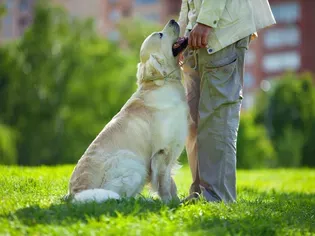How to Train Your Dog to Back Up
Updated on 04/26/24

How to Train Your Dog to Back Up: A Step-by-Step Guide
Introduction
Teaching your furry companion to back up on command is a valuable skill that can enhance both their obedience and overall training. Whether you're navigating through crowded areas, maneuvering around obstacles, or simply want to show off your dog's intelligence, mastering this command will bring countless benefits.
This comprehensive guide will provide you with a step-by-step approach, starting with the basics of positive reinforcement and gradually progressing to more advanced techniques. Along the way, we'll explore real-life examples to illustrate the concepts and reinforce your understanding.
Understanding the Basics
Positive Reinforcement
The foundation of successful dog training lies in positive reinforcement. This means rewarding your dog for desired behaviors with something they enjoy, such as treats, toys, or verbal praise. By associating positive experiences with specific actions, you'll create a strong motivation for your dog to repeat those behaviors.
Body Language
When training your dog to back up, it's essential to use clear and consistent body language. Maintain eye contact with your dog and avoid sudden movements that could startle them. Instead, use gentle hand gestures and verbal cues to guide them through the training process.
Step-by-Step Training
Phase 1: Introduce the Cue
1. Start by introducing the "back up" cue, such as "back" or "reverse." Say the cue in a clear and enthusiastic voice.
2. Reward your dog immediately for focusing on you and listening to the cue, even if they don't perform the desired action yet.
3. Repeat this step until your dog consistently associates the cue with your attention and reward.
Phase 2: Teach the Basic Movement
1. Once your dog understands the cue, start practicing the physical movement. Stand facing your dog and hold a treat in front of their nose.
2. Slowly move the treat backward, encouraging your dog to step back with their front paws.
3. As they take even the smallest step backward, immediately reward them with the treat and verbal praise.
4. Gradually increase the distance you move the treat backward until your dog is taking several steps back on command.
Phase 3: Introduce Obstacles
1. To enhance your dog's understanding, introduce obstacles to their path while practicing the "back up" command.
2. Start with small obstacles, such as a blanket or a chair, and gradually increase the complexity as your dog becomes more proficient.
3. Reward your dog for calmly navigating around the obstacles while maintaining a steady pace.
Phase 4: Practice in Different Environments
1. Once your dog has mastered the command in a controlled environment, it's important to practice in various settings.
2. Take them to a park, a busy street, or a pet-friendly store to expose them to distractions and reinforce their training.
3. Reward your dog for focusing on you and following the "back up" command even when there are potential distractions.
Tips for Success
* Keep training sessions short and sweet: 5-10 minutes is ideal to maintain your dog's attention and prevent boredom.
* Practice regularly: Consistency is key to successful training. Aim for daily training sessions, even if they're just a few minutes long.
* Be patient and reward-oriented: Training should be an enjoyable experience for both you and your dog.
* Avoid punishment: Never use force or harsh words to punish your dog. This will only damage your bond and hinder their progress.
* Seek professional guidance if needed: If you encounter any difficulties during training, don't hesitate to consult with a certified dog trainer for support and guidance.
Examples of Use
* Navigating through crowded areas: Teaching your dog to back up will help you navigate busy streets, sidewalks, or stores without having to pull on their leash or force them to move in a specific direction.
* Opening and closing doors: When your dog knows how to back up, they can easily move away from the door to allow you to open or close it without getting in the way.
* Avoiding obstacles: Whether it's a fallen object in the backyard or a sudden hazard on a walk, teaching your dog to back up can help them avoid potential accidents.
* Training for agility: Backing up is an essential maneuver in agility competitions, allowing dogs to quickly change direction and navigate obstacles.
Conclusion
Teaching your dog to back up on command is a valuable skill that will enhance their obedience, confidence, and safety. By following the step-by-step guide outlined in this blog post, you can effectively train your furry companion to master this command. Remember to be patient, consistent, and reward-oriented throughout the process.
Explore More Pets

Basic Training
Puppy and Baby Introductions

Working Dog Breeds
All About Search and Rescue Dogs

Dog Treatments
Puppy Vaginitis: Signs, Causes and Treatment

Dog Adoption
After More Than 1,200 Days in the Shelter, Coco Goes Home

Basic Training
How to Train Your Puppy to Go on Potty Pads

Hybrid Dog Breeds
The Difference Between a Mutt, Mixed Breed, or Designer Dog?

Dog Treatments
Nail Problems in Dogs

Puppies
7 Reasons Why Two Dogs Are Better Than One